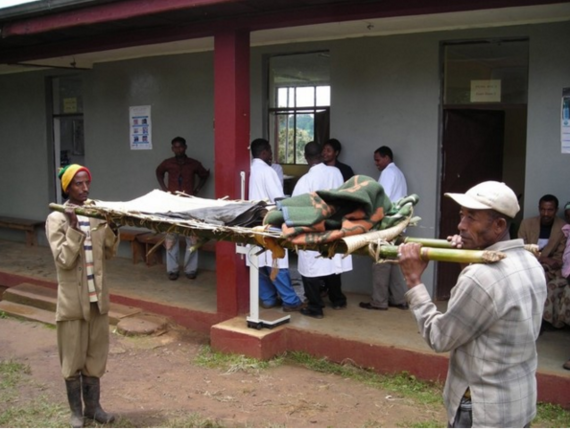Maternal health has made great advances in Ethiopia. In my 10 years conducting research on maternal health, I've seen a big push to build more health facilities and to provide ambulances to transport pregnant women to these facilities.
But one of the big challenges for women is referring them for help from one facility to the next level. Aside from the facilities being very far apart, in some places there are no roads and limited transportation. The women have to walk from facility to facility. Or be carried. This makes it impossible to calculate how much time it will take them.
As more and more health facilities have been built in the past few years, more and more women walk to attend antenatal care clinics and to have a skilled birth attendant deliver their baby.
In Ethiopia just over 80% of the population lives in rural areas. My doctoral research took place in the rural neighbourhoods (kebeles) in Kafa Zone in southwest Ethiopia. It looked at maternal health and how the goal of reducing maternal mortality fits into Ethiopia's development agenda.
But it's impossible to think about maternal health without thinking about the time and distance between where women live in rural kebeles and where the government constructs health facilities: health posts, health centres and hospitals. The three make up a primary health care unit.
There is a health post in each of the kebeles or neighbourhoods, which serves around 5 000 people.
A series of complications
One day in 2007, after hours of walking to interview women in their homes, we met an extended family who invited us into their home.
As squawking chickens ran about and a baby cried, a woman called Birke told me how she had been in labour for three or four days in Sherada in a rural part of Kafa Zone.
Men prepare a stretcher to carry a woman.
Supplied
Her husband's family kept hoping the baby would be born but the labour continued. There was no nurse and no road so she was carried by stretcher for five hours to the road at Gojeb. There she was taken by bus to Bonga.
In Bonga Hospital she was in labour for another two days. The baby died but they didn't remove it as she needed a blood transfusion which could not be done at the hospital. Her husband went home, sold their ox and borrowed extra money for her treatment and the cost of transportation and walked back to the hospital.
Finally, Birke was taken to Jimma Hospital (three to five hours drive away) where the dead baby was removed by caesarean section. Birke left her husband because of ongoing ill health and now lives with her elderly mother and other relatives in Sheyka.
It is not only Birke's area that is like this. In Muti, the women have to balance in the mud when they walk after it rains. And in Deckia the knee-deep mud is on a 50-degree angle and even the mules struggle to find their way.
Changes afoot
Eight years later and on a different research project, I was able to hire a car to visit health facilities and health extension workers in three different regions in Ethiopia.
Health extension workers are community health workers selected from the rural areas they come from. They are trained and return to their communities to provide health care services.
Two health extension workers are based in health posts in a rural kebeles. They provide a range of services including family planning, antenatal care, and other services that aim to halt and reverse the spread of major communicable diseases. But most importantly, they try to encourage women to give birth in health centres rather than at home. Health extension workers can now refer women in labour or prior to labour to health centres by ambulance.
Time is dependent on so many external factors: weather; the availability of men to make a stretcher and carry a woman; the availability of transport; and the availability of trained medical staff to treat the woman at the referral centre.
Throughout my research, as I've waited for the rain to stop or for the bus to leave, while I waited for hours in the queue at the hospital with friends, or outside an office for an interview, I've often felt that waiting was so normalised that it seemed opaque.
Like waiting for the baby to come and hoping everything will be alright.
* If you are a woman who has conducted research in Africa and you'd like to contribute a chapter to an edited book about your experiences, please send Ruth Jackson an abstract of 300 to 350 words along with your name, institutional affiliation and email address by the end of February 2016. We're looking for autobiographical, ethnographic, reflective accounts grounded in theory or a combination of approaches.
Ruth Jackson, Research Fellow of International Development, Deakin University
This article was originally published on The Conversation. Read the original article.
